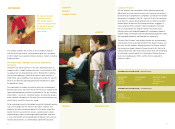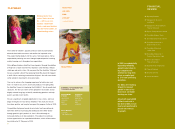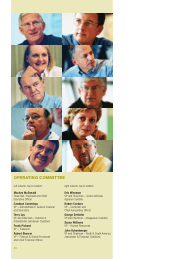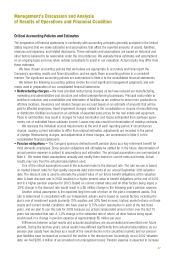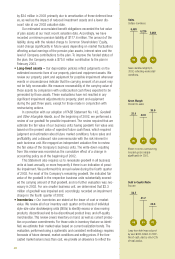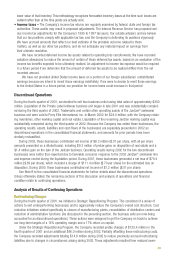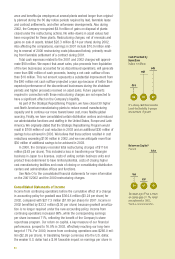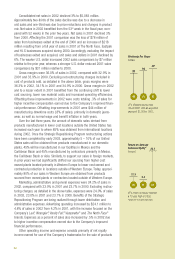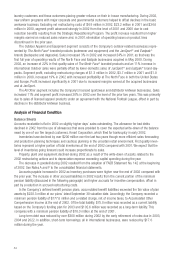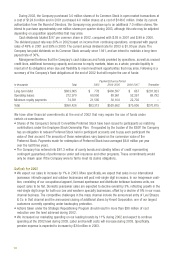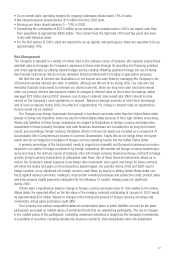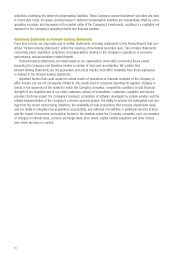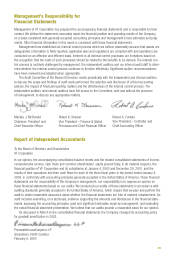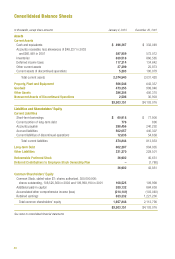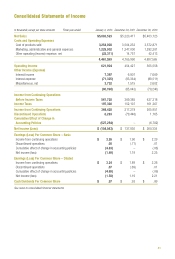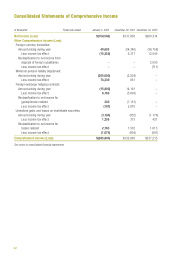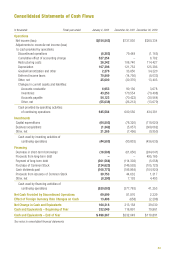North Face 2002 Annual Report Download - page 35
Download and view the complete annual report
Please find page 35 of the 2002 North Face annual report below. You can navigate through the pages in the report by either clicking on the pages listed below, or by using the keyword search tool below to find specific information within the annual report.
by our licensees. Included in 2002 is a charge of $2.3 million for write-off of goodwill; see Note F. Included in
2001 and 2000 is $33.9 million of amortization of goodwill, which is no longer required under FASB Statement
No. 142, as discussed in Note A to the consolidated financial statements. This caption also included $4.0 million
in 2001 for the write-off of intangible assets of a business exited and $26.8 million in 2000 for the loss on dis-
posal, primarily the write-off of intangible assets, of the Wrangler business in Japan.
Net interest expense decreased in 2002 due to lower average borrowings. Net interest expense increased in
2001 due to higher average borrowings related to the 2000 business acquisitions and, to a lesser extent, higher
overall interest rates on the Company’s debt.
The effective income tax rate for continuing operations was 35.1% in 2002, compared with 41.2% in 2001
and 37.8% in 2000. The effective rate declined in 2002 relative to the prior two years due to elimination of
nondeductible goodwill amortization expense, lower foreign operating losses with no related tax benefit and a
lower effective tax rate on foreign earnings. The effective rate benefited in 2000 by higher United States tax
credits recognized in that year.
The Company adopted FASB Statement No. 142 effective at the beginning of 2002. This required change in
accounting policy resulted in a nonrecurring noncash charge of $527.3 million, without tax benefit ($4.69 per
share). See Note A to the consolidated financial statements for additional details. Including the effect of this
accounting change and the discontinued operations discussed in the previous section, the Company reported a
net loss of $154.5 million ($1.38 per share) in 2002, compared with net income of $137.8 million ($1.19 per
share) in 2001 and $260.3 million ($2.21 per share) in 2000.
Information by Business Segment
The Consumer Apparel segment consists of our jeanswear, women’s intimate apparel and children’s apparel busi-
nesses. Overall, segment sales declined by 3% in 2002 and by 4% in 2001. Domestic jeanswear sales declined
4% in 2002 and 5% in 2001 reflecting selected price reductions, changes in product mix, softness in overall retail
apparel sales and pressure from lower priced private label goods, particularly in the mass channel. In European
jeanswear, sales increased 8% in 2002, with one-half of the increase due to favorable effects of foreign currency
translation. Sales in Europe increased 15% in 2001 due to the full year of sales of H.I.S acquired in late 2000 and
growth in the Lee, Wrangler and mass market businesses. In international markets outside of Europe, jeanswear
sales decreased in 2002 due to the devaluation of the currency in Argentina and recessionary economic condi-
tions in Latin America and decreased in 2001 due to the exit of the Wrangler business in Japan and recessionary
conditions in Latin America. Domestic intimate apparel sales declined 4% in 2002 and 1% in 2001, as increases
in department store brands were more than offset by a lack of new private label programs and by a reduction in
Vassarette®brand sales in the mass channel. Sales declined in childrenswear in both 2002 and 2001 due to
competitive factors in the department store channel of distribution. Excluding net restructuring charges of $19.9
million in 2002, $69.4 million in 2001 and $70.9 million in 2000, segment profit advanced 8% in 2002, following
a 17% decline in 2001. The profit increase in 2002 was across all business units, with the exception of children’s
playwear, and was due largely to cost reduction benefits realized from the Strategic Repositioning Program. The
profit decline in 2001 was due to lower sales in domestic jeanswear and playwear, to expenses related to down-
time in domestic jeanswear manufacturing facilities to maintain inventories in line with demand and to operating
losses incurred in Latin America.
To strengthen its business portfolio, the Company has divested certain underperforming and nonstrategic
businesses during the last two years. Considering the factors impacting the children’s playwear business, the
Company has decided to explore strategic options for its childrenswear business unit, including its possible sale.
This business unit had 2002 sales of $175 million of Healthtex ®and licensed Nike®branded products. Any effect
on the Company’s financial position or operating results as a result of actions taken in conjunction with this
process would not be significant.
The Occupational Apparel segment includes the Company’s industrial, career and safety apparel businesses.
Sales decreased 8% in 2002 and 19% in 2001 due to (1) workforce reductions in the United States manufactur-
ing sector that has impacted overall workwear uniform sales and (2) the ongoing consolidation of our industrial
53


